An unusual prehistoric artefact was recovered during the archaeological excavation of one of a pair of Middle Bronze Age structures identified at Knockgraffon, Co. Tipperary (along the N8 Cashel to Mitchelstown Road scheme, see McQuade, Molloy & Moriarty 2009). Each of the structures was defined by a circle of postholes and internally contained a large number of storage pits (see image below).

The object caused some confusion when it was found, from within one of the storage pits, as it bore little resemblance to other published prehistoric artefacts from Ireland. It was made out of baked clay and was roughly pear-shaped in plan (see image below). It had a circular perforation near its butt end, which passed through the body of the artefact. In shape and form it superficially resembled stone mace heads from the Middle Neolithic. However, from a purely functional point of view it seems unlikely that the object was a mace head, as the material it was made from would easily shatter on impact. Although it may have been intended as a ceremonial piece, this also seems unlikely as it had a very crude finish, which would be unusual for an object designed for ritual activity.
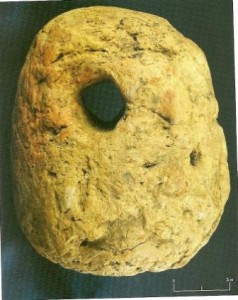
Instead, after some research and a lot of head scratching, a more utilitarian function was suggested by a number of very similar objects from Britain. These artefacts are generally described as loom-weights and are common find on British sites from the Bronze Age onwards. A loom-weight is a heavy perforated item used to maintain tension on the threads during weaving of cloth or fabric on a warp waited loom (see image below). In Britain loom-weights come in many shapes and sizes with cylindrical, triangular and pyramidal being some of the most common forms. A provisional dating suggested by Needham and Longley (1980) places the majority of cylindrical-shaped weights in the middle Bronze age, the pyramidal weights in the Late Bronze Age and the large triangular types in the in the Iron Age. In shape and form the Knockgraffon object is very similar to the pyramidal weights of the British Later Bronze Age. For example, it closely resembles loom-weights from sites such a Runnymede, Surrey (ibid. 406, fig. 4), and Aldermaston Wharf, Berkshire (R. Bradley 1980, 243, fig. 19) (see image below).
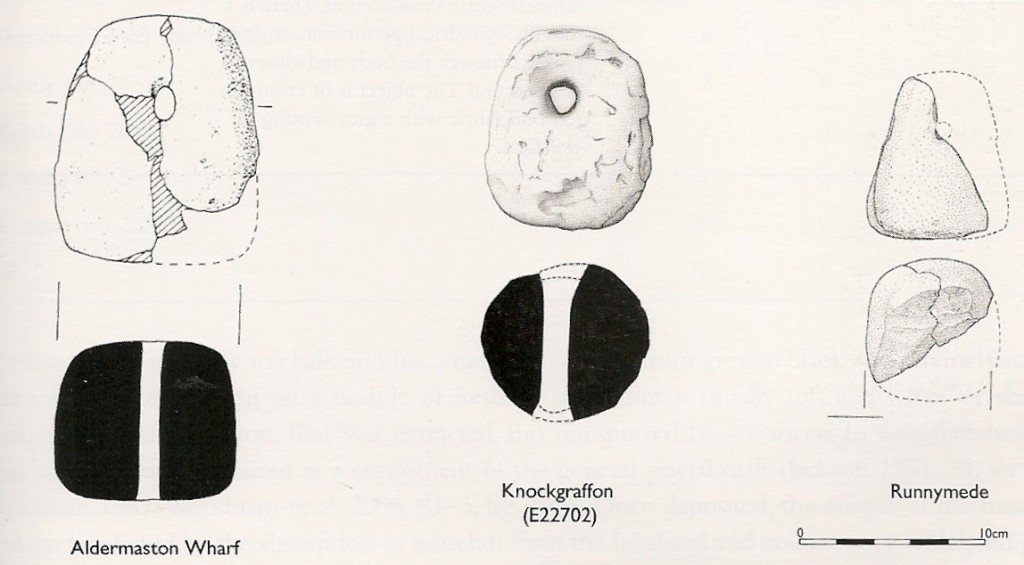
In contrast to Britain, where baked clay loom-weights are common, published Irish examples are extremely rare. The small Irish corpus includes a fragment of a perforated baked clay object from an Early Bronze Age cist burial at Tremoge, Co. Tyrone (Foley 1985). The fragment, which was interpreted as a loom-weight by the excavator, represented about half the object and suggested an overall square or oval shaped with a central perforation. The presence of the loom-weight and bronze awl in association with a female burial led the excavator to suggest that the person interred at this site was a dressmaker (ibid). Fragments of perforated baked clay objects, possibly representing loom-weights, have also been recovered from the Grooved Ware period timber circle at Knowth, Co. Meath. At least one of these objects, represented by three pieces, appears to have been a barrel-or drum-shaped artefact with a central, cylindrical, vertical perforation (Eogan & Roche 1997). This description is reminiscent of the cylindrical loom-weights from the British Middle Bronze Age.
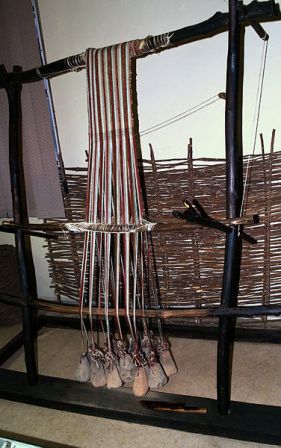
The recovery of the Knockgraffon loom-weight from the smaller of the two buildings at the site is interesting as it could indicate that this structure was associated with textile production, while the larger building was the main domestic residence. This would parallel the archaeological evidence from Britain, where Middle Bronze Age circular buildings often occur in pairs, with the larger building being the main domestic dwelling and the smaller structure being associated with craft production, especially weaving (Ellison 1981).
As far as I know the Knockgraffon artefact is the only complete prehistoric, baked clay, loom-weight thus far recovered from Ireland. It is an important artefact as it demonstrates a relatively sophisticated means of producing fabric was in use during the Irish Bronze Age and it would be interesting to know if any other similar objects have turned up on recent archaeological excavations. Is it possible that some of the fragments of baked clay, which are often found at prehistoric sites in Ireland, actually represent the broken remains of loom-weights? I suppose time, and a bit of research, will tell.
References
Ellison, A 1981 ‘Towards a socioeconomic model for the Middle Bronze Age in Southern England’ in I Hodder, G Isaac & N Hammonds (eds), Pattern of the Past: studies in honour of David Clarke, 413-38, Cambridge University Press, Cambridge
Eogan, G & Roche H. 1997 Excavations at Knowth 2. Royal Irish Academy Press
Foley, C 1985 ‘A cist burial at Tremoge, Co. Tyrone’, Ulster Journal of Archaeology, Vol. 48, 63-8
McQuade, M, Molloy, B & Moriarty C, 2009 In the Shadow of the Galtees; Archaeological excavations along the N8 Cashel to Mitchelstown Road Scheme, The National Roads Authority
Needham, S & Longley, D 1980 ‘Runnymede Bridge, Egham: A Late Bronze age riverside settlement’, in J. Barrett and R. Bradley (eds), The British Later Bronze Age, 397-436, British Archaeological Reports, British Series 83 (ii), Oxford

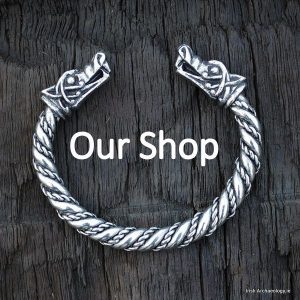
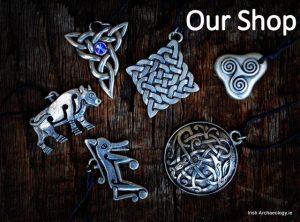
This is an interesting find, well worth highlighting, and throws up a number of questions. There was very little animal bone present at the site and no sheep bones were identified. Assuming wool was being woven at the site, where were the rest of the animals being processed/consumed? If not on this site, could that indicate that Knockgraffon was a specialist weaving site importing wool from another farm(s)?
Hi Charles, interesting point and now you’ve got me thinking. The houses were located in the lee of a large and quite steep hill (Knockgraffon), which may have been more suitable for raising sheep that other livestock or crops. Maybe the inhabitants of the houses, located there because it was close to their source of wool? The only thing about the lack of sheep bone from the site is that we found very little animal bone (or artefacts) from our Bronze Age sites in general. Not really sure why, but it may have been related to disturbance cause by deep ploughing (very intensive farming in the locality) or the underlying soil conditions.
On a farm in the Orkney Islands I found a complete stone loom weight. Is this find something to report? If so, who should I notify? Do you have a Scottish counter part? cw
Were no loom weights found at the large Corrstown settlement? That’s where I would expect them at least..
I am looking at your picture of the prehistoric loom. Are you sure that the loom hasn’t been warped upside down. From a weavers point of view it makes more sense if the cloth beam was at the bottom and the warp with its loom weights was passed over the top beam.
This would mean that the weaver would be able to beat down and work seated. I would be interested to hear if there is any evidence for your set up.